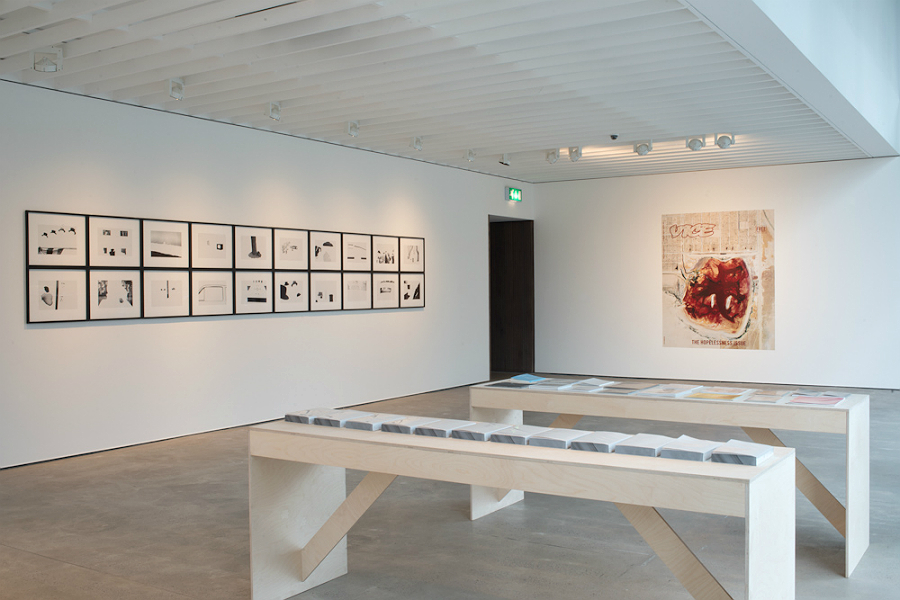The Importance (or otherwise) of Interpretation

Approaching graduation, Darren Murphy is increasingly thinking about how art is presented and interpreted in a gallery context…
“Much of the labour of [nurturing the art market] is in the management of the informational prosthesis of the circulating artworks; through producing press releases and exhibition invites, buying advertising space, placing articles in newspapers and magazines, publishing catalogues, documenting and archiving artworks, and by cultivating critics, editors and publishers.”
– Neil Cummings, Circulating Artworks
With parameters in place to establish The Difference Between the Blogger and the Art Critic it’s interesting to consider the influence institutes, galleries, art spaces, etc. have on art criticism, whether it be on the blogger or the critic.
As I near the end of my time at University, presenting myself to the outside world takes on more significance that it ever has before. A part of this presentation, as an artist, is my artist statement – what am I and my work about? In work-shopping this with friends an invaluable piece of feedback I received is to distance myself from solid theories and dense terms, feedback also given by Daniel Blight in The Guardian.
Neil Cummings’ definition of ‘informational prosthesis’ – written materials that exist in parallel to art works such as statements, press releases, criticism, etc. – seems to assume the purpose of these texts is to increase value, increase marketability of work, and if not increase value in monetary terms, then in cultural terms.
As with an artist’s statement, and by extension, why would a gallery/institute/art space want to tell people what a work is about? Why would it be of benefit to spoon-feed the audience in this manner? In doing so, you give the audience a criteria to assess the work, which they can choose to agree with (the aim being to increase value) or disagree with (thus potentially decreasing value), rather than allowing them to grapple with it personally thus, ultimately, risking indifference.
It seems, the short answer at least, is that they don’t. It came as a revelation to most that Penelope Curtis, Director of Tate Britain, scrapped interpretation. This was, apparently, done to allow people to reach their own conclusions, explore the work without the words.
When we talk about the Tate’s collection it’s hard to consider this as a mechanism for defending or augmenting value (it’s the Tate for goodness sake). But this sets a precedent, or illustrates something that’s already happening elsewhere. How often do you go to a gallery and view a work and have a text to hand telling you what it’s about? Not as much as you might once have done.
Of course, when I say agreeing with an interpretation increases a work’s value and disagreeing decreases it, I’m being incredibly blasé. In disagreeing with an interpretation, often you begin to engage with the work more than when you agree. That said, this can often result in an “I don’t get it” response when disagreeing with an interpretation, which amounts to little more than a dead end on all fronts.
Perhaps this returns us to the question of the role of opinion in a critic’s work? There is a difference between being told what to see in a subjective sense, and what to look for in objective terms. The former being imagery, themes, topics or subjects; the latter allowing for an appreciation of skill, technique, intelligence, maybe even aesthetics.
Or maybe the art world (rightly or wrongly) is merely returning to an approach like that of a Vanity Fair writer many years ago who wrote along the lines of: “some stupid people don’t get art as some art isn’t made for stupid people.” What value does interpretation have, should people be left to find their own way as with the Tate, or should critics give them foundations to build upon? Does interpretation matter?
Darren Murphy
Darren is the founder of Not Too Critical, an inclusive and informal discussion group hoping to incite debate and discussion on matters and subjects pertaining to the contemporary arts
Darren’s thoughts on modern criticism will be serialised on The Double Negative over the next few weeks
Image courtesy Mark McNulty





